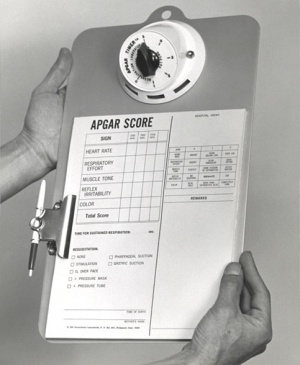Apgar test: Difference between revisions
No edit summary |
No edit summary |
||
| Line 44: | Line 44: | ||
|} | |} | ||
=== Recent Apgar Studies === | |||
* management of eclampsia patients at a tertiary hospital in Dar es Salaam, Tanzania. Kidanto HL, Mogren I, Massawe SN, Lindmark G, Nystrom L. BMC Pregnancy Childbirth. 2009 Mar 27;9:13. [http://www.ncbi.nlm.nih.gov/pmc/articles/PMC2670267/ PMCID: PMC2670812] | |||
:"A five-minute Apgar score <7 has a consistent association with prevalence of neurologic disability and with low cognitive function in early adulthood." | |||
Two large neonatal studies have examined whether the Apgar score is still a relevant neonatal assessment tool. | |||
* Low 5-minute Apgar score: a population-based register study of 1 million term births. Thorngren-Jerneck K, Herbst A. Obstet Gynecol. 2001 Jul;98(1):65-70. [http://www.ncbi.nlm.nih.gov:80/entrez/query.fcgi?cmd=Retrieve&db=pubmed&dopt=Abstract&list_uids=11430958 PMID: 11430958] | |||
* The continuing value of the Apgar score for the assessment of newborn infants. Casey BM, McIntire DD, Leveno KJ N Engl J Med. 2001 Feb 15;344(7):467-71. [http://www.ncbi.nlm.nih.gov:80/entrez/query.fcgi?cmd=Retrieve&db=pubmed&dopt=Abstract&list_uids=11172187 PMID: 11172187] | |||
Revision as of 13:45, 27 May 2010
A historic neonatal test designed by Dr Virginia Apgar[1] used in nearly all maternity clinics to assess the newborn infants well being assigned scores for each of 5 indicators: Heart Rate, Respiratory Effort, Reflex Irritability, Muscle Tone, Colour
Measured at one and five minutes after birth the Score values are totalled for all indicators: 7-10 is considered normal, 4-7 may require resuscitative measures, 3 and below require immediate resuscitation.
In recent years there has been some controversy of the relevance and accuracy of some of the criteria used in this test, though many feel it is still an invaluable initial assessment tool particularly where medical services are limited.
| Indicator | Score 0 | Score 1 | Score 2 |
| Activity (muscle tone) | Limp; no movement | Some flexion of arms and legs | Active motion |
| Pulse (heart rate) | No heart rate | Fewer than 100 beats per minute | At least 100 beats per minute |
| Grimace (reflex response) | No response to airways being suctioned | Grimace during suctioning | Grimace and pull away, cough, or sneeze during suctioning |
| Appearance (color) | The baby's whole body is completely bluish-gray or pale | Good color in body with bluish hands or feet | Good color all over |
| Respiration (breathing) | Not breathing | Weak cry; may sound like whimpering, slow or irregular breathing | Good, strong cry; normal rate and effort of breathing |
Recent Apgar Studies
- management of eclampsia patients at a tertiary hospital in Dar es Salaam, Tanzania. Kidanto HL, Mogren I, Massawe SN, Lindmark G, Nystrom L. BMC Pregnancy Childbirth. 2009 Mar 27;9:13. PMCID: PMC2670812
- "A five-minute Apgar score <7 has a consistent association with prevalence of neurologic disability and with low cognitive function in early adulthood."
Two large neonatal studies have examined whether the Apgar score is still a relevant neonatal assessment tool.
- Low 5-minute Apgar score: a population-based register study of 1 million term births. Thorngren-Jerneck K, Herbst A. Obstet Gynecol. 2001 Jul;98(1):65-70. PMID: 11430958
- The continuing value of the Apgar score for the assessment of newborn infants. Casey BM, McIntire DD, Leveno KJ N Engl J Med. 2001 Feb 15;344(7):467-71. PMID: 11172187
References
- ↑ <pubmed>13083014</pubmed>
Search Pubmed
Search PubMed: Apgar | Apgar test | Virginia Apgar
Glossary Links
- Glossary: A | B | C | D | E | F | G | H | I | J | K | L | M | N | O | P | Q | R | S | T | U | V | W | X | Y | Z | Numbers | Symbols | Term Link
Cite this page: Hill, M.A. (2024, April 19) Embryology Apgar test. Retrieved from https://embryology.med.unsw.edu.au/embryology/index.php/Apgar_test
- © Dr Mark Hill 2024, UNSW Embryology ISBN: 978 0 7334 2609 4 - UNSW CRICOS Provider Code No. 00098G
